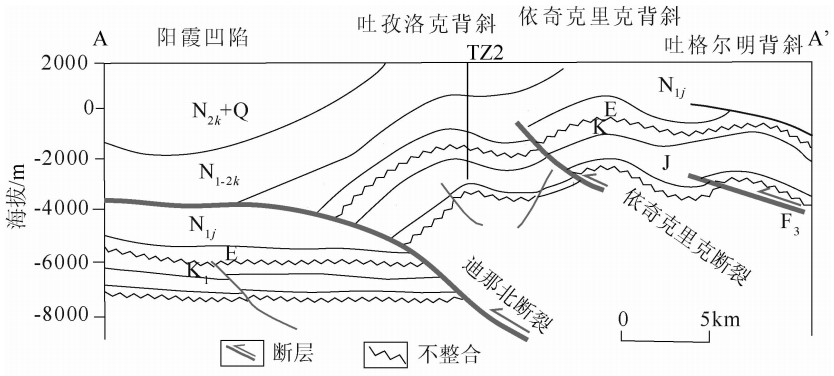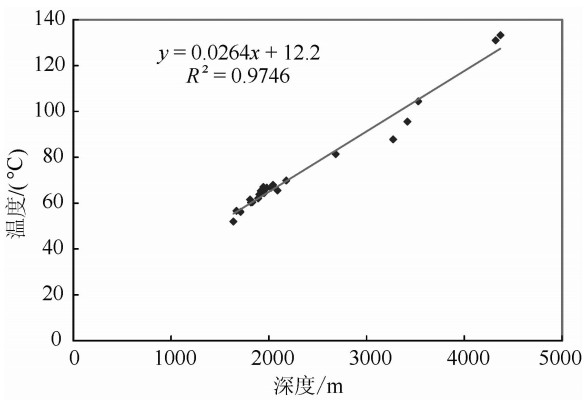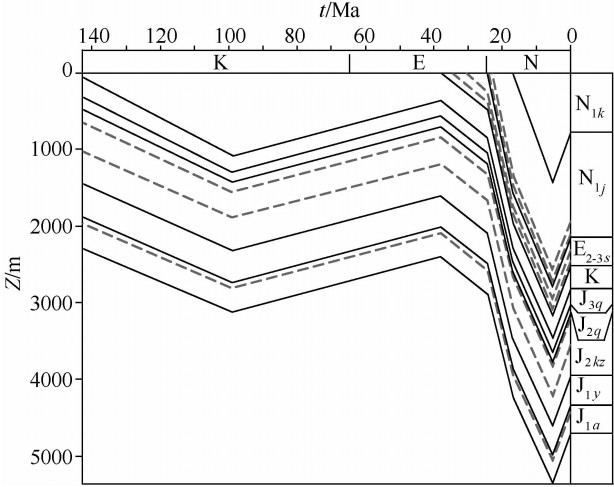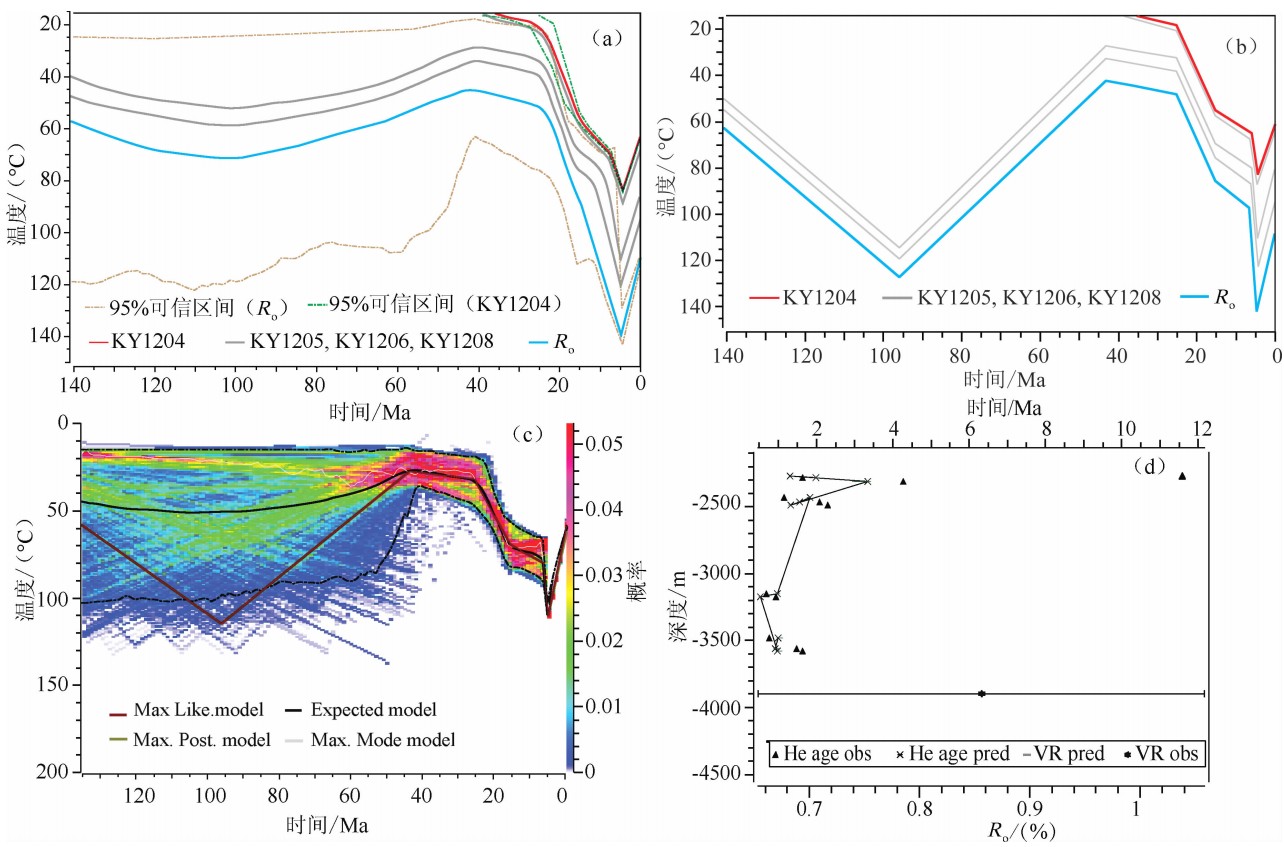2. 大陆构造与动力学国家重点实验室, 北京 100037;
3. 中国石油大学(北京) 地球科学学院, 北京 102249;
4. John De Laeter Center for Isotope Research, Applied Geology/Applied Physics, Curtin University, Perth, Australia
2. National Key Laboratory of Continental Structure and Dynamics, Beijing 100037, China;
3. College of Geosciences , China University of Petroleum, Beijing 102249, China;
4. John De Laeter Center for Isotope Research, Applied Geology/Applied Physics, Curtin University, Perth, Australia
位于塔里木盆地与天山造山带的交接部位的库车前陆盆地蕴藏着丰富的油气资源.库车盆地中新生代经历了多幕次构造活动、多期沉积间断和剥蚀,中新生代盆地的构造热演化史一直缺乏有效的研究,导致了库车盆地中生代烃源岩生烃演化时期和生烃潜力的认识不一,制约了油气勘探.国内学者对库车盆地现今地温和大地热流分布特征等进行研究(刘绍文等, 2006; 王良书, 2003, 2005),认为库车盆地现今平均地温梯度值为18~28 ℃/km.库车盆地的热演化史主要依据镜质体反射率(Ro)法(王飞宇, 1999, 2005; 李梅等, 2004; 杨树春等, 2005)进行研究,然而由于库车盆地多幕次构造活动引起多期次沉积间断及地层重复等,镜质体反射率(Ro)与其深度之间不呈线性关系,给热史研究带来困难(李梅等, 2004),因而,该方法多用于依南2井(地层连续沉积)的热史研究(高岗等, 2002; 李贤庆等, 2004).
库车盆地不同构造带烃源岩生排烃时间与构造活动时间相匹配为油气聚集的关键,有利油气圈闭的形成要求构造形成时间与油气运移的时间相匹配.卢华复及刘志宏等利用生长断层相关褶皱理论详细地研究了库车盆地内各构造带形成时间(卢华复等, 1999; 刘志宏等, 2000a),然而由于库车地区新生界为陆相地层,缺少古生物化石和同位素定年资料,新生界地层单元时代存在争议(李忠等, 2003),使一些构造变形的起始时间研究也存在分歧,如亚肯背斜的形成时间有1.2 Ma(刘志宏等, 2000a)、1.8 Ma(卢华复等, 1999)、5.2 Ma(汪新等, 2002)三种观点.另外,少数学者利用裂变径迹数据分析了吐格尔明背斜(杨树锋等, 2003)及捷斯德里克背斜形成时间(罗梦等, 2012).
近年来国际上新发展的(U-Th) /He技术广泛应用于地质体定年(Lippolt et al., 1995; Reiners et al., 2000)、古地形演化(Ehlers et al., 2003; House et al., 1998; Reiners et al., 2003)、沉积物源追踪(Ehlers et al., 2003; Ehlers et al., 2006; Rahl et al., 2007)等方面,也是区域热史演化(Taylor et al., 2011; Juez-Larré et al., 2006; 周祖翼等, 2002)、构造隆升剥蚀史(Flowers et al., 2008; Soderlund et al., 2005; Wolf et al., 1997) 研究的一种有效手段.(U-Th) /He热定年测试的矿物包括橄榄石、辉石、角闪石、石榴子石、磷灰石、锆石、榍石、磁铁矿、赤铁矿等,目前应用较多的是磷灰石、锆石和榍石,特别是磷灰石(U-Th) /He定年技术具有对低温条件的敏感性(40~85 ℃)和较低的封闭温度(Wolf et al., 1998),记录了地质历史中最新和最近的信息(地表下1~3 km深度),这也为研究盆地构造热演化史及隆升剥蚀史等问题提供了一种新途径.国内学者主要利用该技术研究造山带的构造热演化史(周祖翼等, 2003; 丁汝鑫等, 2006; 许长海等, 2010),邱楠生等(2010)通过钻井样品的磷灰石和锆石(U-Th)/He等数据,模拟恢复了塔里木盆地KQ1和T1井早古生代的构造热演化历史(Qiu et al., 2012),为(U-Th)/He技术在塔里木盆地的应用奠定了基础.本文利用钻井样品磷灰石和锆石(U-Th)/He等数据研究库车盆地吐孜洛克背斜构造热演化,探讨中新生代吐孜洛克背斜形成时间及隆升剥蚀史等,这对研究该区烃源岩生烃演化史、油气运移及成藏等具有重要的意义.
库车盆地是在塔里木地块北缘古生代褶皱带的基础上发展起来的中、新生代盆地,经历了晚二叠世-三叠纪的前陆盆地、侏罗-古近纪的伸展坳陷盆地和新近纪-第四纪陆内前陆盆地的演化,多数学者把库车盆地称为前陆盆地或再生前陆盆地(刘和甫等, 1994; Lu et al., 1994; 刘志宏等, 2000a,2000b).始新世末天山板内造山带受印度板块与欧亚板块碰撞影响发生强烈隆升并向两侧盆地内扩展(卢华复等, 1999; 刘志宏等, 2000b),在库车盆地内形成一系列向南运动的逆冲断层和相关褶皱组合,其展布方向与南天山碰撞造山带近于平行.依据断层及其相关褶皱的构造变形和空间组合特征(刘志宏等, 2000b),将库车前陆盆地由北向南划分为北部单斜带、克拉苏—依奇克里克构造带、拜城—阳霞凹陷带、秋立塔克构造带和前缘隆起带(图1),其中克拉苏-依奇克里克构造带以发现克拉2、克拉3、吐孜1和依南2 等气田备受关注.
 | 图1 库车盆地构造区划图 Fig.1 Sketch map of structural units in the Kuqa Basin |
吐孜洛克背斜位于库车盆地依奇克里克构造带东段,其东与吐格尔明背斜相邻,向西以鞍部与依南2断鼻过渡,北与依奇克里克背斜以断层为界,南与迪那背斜断层为界(分别位于依奇克里克断裂下降盘,迪那北断裂上升盘),总体为北西西向展布的挤压背斜构造.新生代库车盆地的构造变形自北向南依次扩展(刘志宏等, 2000a; 卢华复等, 1999),吉迪克组沉积期依奇克里克背斜因逆冲断层(依奇克里克断裂)侵位而开始形成,康村组-库车组沉积期变形作用扩展到吐孜洛克背斜,迪那北断裂开始形成(图2).北部依奇克里克断裂的发育控制了吐孜洛克构造北部形态以及吐孜洛克气田圈闭发育的规模.南部迪那北断裂是控制吐孜洛克背斜形成的断层,该断层的发育使整个吐孜洛克地区抬升,结合北部的挤压形成背斜.因此,依奇克里克断裂及迪那北断裂控制着吐孜洛克构造的形成和演化.
 | 图2 吐孜洛克背斜南北向剖面图(剖面位置见图1) Fig.2 The geologic section of the Tuziluoke anticline |
吐孜2井位于吐孜洛克背斜东北翼(图2),钻井深度为4409 m,自上而下所钻遇地层为:新近系康村组(N1-2k)、吉迪克组(N1j),古近系苏维依组(E2-3s),白垩系舒善河组(K1s)、亚格列木组(K1y), 侏罗系齐古组(J3q)、恰克马克组(J2q)、克孜勒努尔组(J2k)、阳霞组(J1y)、阿合组(J1a).所钻地层缺失白垩系巴什基奇克组(K2bs)、巴西盖组(K1b),古近系库姆格列木群(E1-2 km),新近系库车组(N2k)、西域组(Q1x).由于缺乏有效的定年标志,库车盆地新生代生物地层时代及其相互接触关系存在较大的不确定性,目前库车盆地新生代地层年代主要依据磁性地层学和生物地层学的研究确定(李忠等, 2003; 邓秀芹等, 1998; 滕志宏等, 1997; Huang et al., 2006).
库车前陆盆地中新生代盆地沉积了数千米的碎屑岩,为磷灰石及锆石样品挑选提供了理想的条件.吐孜洛克背斜上吐孜2井和吐孜3井现今试油和钻井测试温度与现今深度具有良好的线性关系,据此可获得该地区现今地温梯度为26.4 ℃/km,平均地表温度为12.2 ℃(图3).本次采集了吐孜2井深度1893~4406 m砂岩样品(表1),选取磷灰石及锆石 矿物,测试磷灰石样品主要分布深度为1893~3513 m, 现今温度分布在62~105 ℃,锆石样品深度为3154~4406 m, 现今温度分布在96~129 ℃,具体样品所处深度和对应的现今温度见表1.
 | 图3 吐孜洛克背斜现今温度与深度关系图 Fig.3 The relationship between present temperature and depth from TZ2 and TZ3 in the Kuqa Basin |
|
|
表1 库车盆地吐孜2井样品分布表 Table 1 The distribution of apatite samples from TZ2 in the Kuqa Basin |
磷灰石和锆石(U-Th)/He年龄测试在澳大利亚科廷大学John De Laeter Center进行.在显微镜下挑选晶形较好、不含包裹体(尽可能少),且直径大于70 μm的磷灰石和锆石颗粒(减少FT校正误差),并在显微镜下测量矿物颗粒的大小,计算α校 正因子(FT)(Farley et al., 1996).将测量好的矿物,颗粒放入Pt包(磷灰石)及Nb包(锆石)中,利用1064 nm Nd-YAG激光加热单颗粒矿物,抽取4He. 4He测量结果根据同位素稀释剂3He量进行计算,并依据4He标准罐进行校准,总体上He的测量精度(RSD)小于1%.
磷灰石和锆石U和Th含量根据同位素稀释电 感耦合等离子体质谱法测定,其具体处理过程不同.锆石化学处理: 将测完He的锆石样品加入25 μL 235U和230Th稀释剂溶液(包含15 ppb 235U和15 ppb 230Th)及350 μL HF溶液,放入高压溶样罐中,恒温240 ℃加热40 h;同时在25 μL标准溶液(包含77 ppb U和77 ppb Th)中加入25 μL稀释剂溶液.从高压溶样罐中取出样品蒸干,再加入300 μL HCl恒温200 ℃加热24 h溶解氟化物.最后将溶液酸性稀释到10%,在Agilent 7500CS电感耦合等离子体质谱仪上分析,U和Th同位素比值测量的精度小于2% (Evans et al., 2005).磷灰石的化学处理:25 μL浓度为50% HNO3(体积比,大约7 mol/L)的稀释剂溶液(包含约15ppb 235U 和5 ppb 230Th)加入到测完He的磷灰石样品中.磷灰石颗粒在酸性稀释剂溶液中溶解12 h.25 μL标准溶液(27 ppb U和27 ppb Th)中加入25 μL稀释剂溶液.然后在标准溶液和样品中各加入250 μL 蒸馏水,最后利用ICPMS进行分析.总体上磷灰石(U-Th)/He热年代学方法测量精度小于2.5% (Evans et al., 2005).每个磷灰石或锆石样品选择了3~5个颗粒进行测试.
磷灰石及锆石(U-Th)/He年龄测试数据见表2和表3.热模拟实验研究表明磷灰石He部分保留区(Helium Partial Retention Zone,He PRZ)为40~85 ℃ (Wolf et al., 1998),磷灰石(U-Th)/He封闭温度为75±5 ℃(Wolf et al., 1996),然而由于影响He封闭温度因素较多,如颗粒半径、冷却速率、有效铀浓度、辐射损伤等( Farley, 2000; Shuster et al., 2006; Flowers et al., 2009; Reiners et al., 2001 ),不同盆地的自然样品的He 封闭温度存在差异(Warnock et al., 1997; 常健等, 2012).根据吐孜2井磷灰石样品(U-Th)/He年龄与沉积地层年龄的关系(图4),将磷灰石样品分为两组,一组为样品深度小于2200 m,包括KY1201、KY1202两个样品,表现为磷灰石He年龄大于沉积地层年龄,表明磷灰石(U-Th)/He体系未发生过重置,样品沉积埋藏最大的温度没达到磷灰石(U-Th)/He封闭温度,反映了物源区的信息,而同一样品不同颗粒间磷灰石He年龄差别较大,表明该样品物源可能来源不同地区;另外一组为样品深度大于2200 m,包括KY1204、KY1205、KY1206、KY1208四个样品, 表现为磷灰石He年龄小于沉积地层年龄,KY1204、KY1205、KY1206 样品现今温度为74~96 ℃,磷灰石He年龄较小,是否发生过重置及沉积埋藏经历最大的温度是否到达磷灰石(U-Th)/He封闭温度,还需要进一步探讨;样品KY1208现今温度大于100 ℃,高于磷灰石(U-Th)/He封闭温度,磷灰石He年龄接近零.由于吐孜2井磷灰石样品现今温度处于60~105 ℃,磷灰石都不同程度进入He部分保留区,磷灰石He年龄随温度/深度变化具有一定规律性(图4),即随着温度/深度的增加,磷灰石He年龄总体上减小,大约深度为2900 m对应磷灰石(U-Th)/He封闭温度为89 ℃(依据平均地温梯度为26.4 ℃/km及地表温度为12.2 ℃计算),这与塔里木盆地磷灰石(U-Th)/He封闭温度(88±5 ℃)大致相同(Qiu et al., 2012; 常健等, 2012);同时,磷灰石(U-Th)/He年龄随深度/温度变化的模式与Wolf等(1998)建立的模式总体上是一致的,与邱楠生等(2010)研究塔里盆地的结果也一致.
|
|
表2 库车盆地吐孜2井磷灰石(U-Th)/He年龄测试结果 Table 2 Measured (U-Th)/He ages of apatite samples from TZ2 in the Kuqa Basin |
|
|
表3 库车盆地吐孜2井锆石(U-Th)/He年龄测试结果 Table 3 Measured (U-Th)/He ages of zircon samples from TZ2 in the Kuqa Basin |
 | 图4 库车盆地吐孜2井磷灰石/锆石(U-Th)/He年龄 与样品深度和温度的关系(绿色线为Wolf等(1998)建立的模式;PRZ为磷灰石He部分保留区) Fig.4 The relationship between apatite/zircon He ages and depth and temperature from TZ2 in the Kuqa Basin (Green line is the model from Wolf et al.(1998)) |
锆石样品KY1206和KY1208的He年龄大于沉积地层年龄,反映物源区信息,同一样品He年龄较为分散亦表明了该样品物源较为广泛.样品KY1211的He年龄接近沉积地层年龄,样品现今温度约为129 ℃,而现有研究表明锆石He部分保留区为130~200 ℃(Wolfe et al., 2010),推测KY1211沉积过程中经历最大温度仍没达到锆石(U-Th)/He封闭温度.
为了更好地理解(U-Th)/He年龄的意义,根据吐孜2井钻井分层数据及剥蚀量数据等,利用Sclater和Christie的模型(Sclater et al., 1980)进行压实校正,对吐孜2井沉积埋藏史进行了恢复(图5).吐孜2井自中生代开始进入稳定沉积阶段,早侏罗纪沉积速率较大,白垩纪沉积缓慢,在白垩纪末期发生了一次较大的区域性抬升,剥蚀了上白垩统巴什基奇克组、巴西盖组及古近系库姆格列木群;新近纪中新世进入快速沉积阶段,沉积了厚度2100 m 吉迪克组(24.4~16.9 Ma)和康村组(16.9~5.3 Ma), 沉积速率分别为约182.3 m/Ma和67 m/Ma;上新世吐孜洛克背斜开始抬升剥蚀,吐孜2井剥蚀了库车组(5.3~3.4 Ma)和西域组(3.4~1.5 Ma)等数百米地层(地层年代据李忠等(2003)).
 | 图5 吐孜2井地层埋藏史(虚线为样品埋藏史) Fig.5 The burial history of Well TZ2 and samples (The dashed lines are burial history of samples) |
磷灰石及锆石样品埋藏史见图5(虚线).由图可知,样品在康村组沉积末期(5.3 Ma)埋藏达到最深.此外,样品KY1206、KY1208及KY1211在晚白垩纪经历了一次抬升,KY1208抬升前埋藏最深为1900 m,依据梁狄刚等1)研究白垩纪古地温梯度为29 ℃/km,古地表温度为16 ℃,计算得KY1208白垩纪经历最高温度约为71 ℃,并没达到磷灰石(U- Th)/He封闭温度,小于样品现今温度(105 ℃),表明了样品长期处于半保留区(40~85 ℃)(Wolf et al., 1998).吉迪克组沉积末期(16.9 Ma)样品KY1205埋藏深度约为1900 m,对应温度约为65 ℃ (依据地温梯度为27 ℃/km及地表温度14 ℃计 算1)),康村组沉积末期(5.3 Ma)埋藏深度约为3050 m,对应温度约为96 ℃;对于KY1204样品吉迪克组沉积末期(16.9 Ma)埋深为1700 m,温度约为60 ℃,康村组沉积末期(5.3 Ma)埋藏深度约为2900 m,对应温度约为92 ℃.
1)梁狄刚,张水昌,金之钧等.2000.塔里木盆地油气源及成藏研究.//“九五”国家重点科技攻关项目(99-111-01-03)成果报告.北京:中国石油勘探开发研究院,132-166.受新生代印度-欧亚碰撞远程效应向北传播的影响,新生代库车褶皱带变形强烈,盆地内各构造带变形时间由北向南逐渐变新(卢华复等, 1999; 刘志宏等, 2000a).刘志宏等(2000a)利用生长断层相关褶皱理论模型确定吐孜洛克背斜开始形成时间为5.3 Ma,即在康村组沉积末期(5.3 Ma)吐孜洛克背斜开始抬升并一直持续到现今,这与吐孜2井钻井显示地层缺失了库车组(5.3~3.4 Ma)及上部地层对应.事实上,依奇克里克构造带地区大量钻井表明该构造带不同程度地缺失了库车组及以上地层,亦表明了在康村组沉积末期依奇克里克构造带一次构造隆升剥蚀事件.
根据以上区域构造背景结合吐孜2井埋藏史、磷灰石(U-Th)/He年龄数据等进行热史模拟.样品KY1205的磷灰石He年龄平均值为3.3 Ma,记录了吐孜2井新生代抬升剥蚀年龄.选用KY1205样品进行热史模拟,模拟软件采用HeFTy(2012 年版本),在热史模拟时,先依据冷却事件年龄和本区构造、盆地埋藏史分析的成果,设定Monte Carlo箱,即热史模拟之前预设的控制时间-温度变化的范围(Ketcham, 2005).采用Monte Carlo方法随机模拟100条较好温度路径(Good Paths,GOF>0.5),选择其中“最好”的温度路径代表该样品的热史(图6).模拟结果表明样品KY1205经历了古近纪及新近纪升温阶段后,在5 Ma发生快速抬升并持续至今.
 | 图6 吐孜2井样品KY1205热历史模拟图(黑色线为较好的路径,灰色的线是可接受的路径,白色线为最好的路径) Fig.6 Thermal history modeling of the sample KY1205 from well TZ2 using HeFTy software |
此外,我们利用QTQt软件(Gallagher, 2012)对吐孜2井剖面上多个样品联合模拟.根据磷灰石He年龄小于地层年龄,反映了沉积区热信息,选取KY1204、KY1205、KY1206、KY1208进行模拟.另外,选取了吐孜2井阳霞组泥岩镜质体反射率(Ro)进行模拟(深度4104 m,Ro值为0.848),补充磷灰石(U-Th)/He反映深层热信息的不足.利用QTQt模拟吐孜2井热史见图7,结果表明吐孜2井经历了两次抬升事件,第一次抬升起始时间为约100 Ma(早白垩纪末),到约45 Ma(始新世)结束,与利用裂变径迹研究本区100 Ma的一次隆升事件一致(罗梦等, 2012; 杜治利等, 2007; 贾承造等, 2003; 杨庚等, 1995),也与本区地层缺失下白垩统对应,然而受样品所反映热信息的限制,此次抬升幅度的模拟结果存在差异(图7a,b).第二次抬升剥蚀起始时间约为5 Ma,新近纪开始由于地层快速埋藏,样品经历的温度迅速升高,在约5 Ma样品的经历温度达到最高,随后迅速抬升剥蚀.
 | 图7 吐孜2井样品QTQt软件模拟图 (a)样品期望热史模拟,其中红色线为样品KY1204热史路径,灰色线分别为样品KY1205、KY1206及KY1208热史路径,蓝色线为镜质体反射率(Ro)样品热演化路径;(b)最大后验热史模拟;(c)样品KY1206热史模拟;(d)He年龄观测及预测值. Fig.7 Thermal history modeling of well TZ2 using QTQt software (a) Thermal history of Expected model, the red line is sample KY1204, the gray lines are sample KY1205, KY1206 and KY1208, the blue line is Ro;(b) Thermal history of Max. posterior model;(c) Thermal history of KY1206; (d) Observed and predicted He age. |
热史模拟、沉积地层记录及生长地层研究表明,吐孜洛克背斜在康村组沉积末期至今发生强烈的抬升.吐孜2井磷灰石(U-Th)/He封闭温度为89 ℃,现今地温梯度为26.4 ℃/km,地表温度12.2 ℃,磷灰石封闭温度对应的深度为2900 m.KY1202 现今温度为68 ℃,对应深度为2133 m,测得的磷灰石He年龄大于地层年龄,表明了样品没发生重置过,即最大埋深没超过2900 m,KY1202样品现今埋深 为2133 m,则可限定该井最大抬升剥蚀量为767 m. KY1204现今温度为73 ℃,深度为2327,由于磷灰石He年龄小于地层的年龄,结合埋藏史分析认为该样品最小埋深超过2900 m,则可限定KY1204样品最小抬升剥蚀量为573 m.因此,吐孜2井新生代 抬升的剥蚀量可限定在573~767 m, 平均值为670 m.KY1205现今温度为76.9 ℃,深度为2460 m,磷灰石He年龄平均值为3.3 Ma,则可计算其平均抬升剥蚀速率为0.133 mm/a.根据吐孜2井抬升剥蚀量及剥蚀速率,计算可求得吐孜2井抬升剥蚀起始时间为4.31~5.77 Ma,平均值为5.04 Ma,计算表明吐孜2井约在5 Ma左右开始抬升剥蚀,这与刘志宏等(2000a,2000b)根据野外和地震剖面识别出生长地层和生长三角,确定吐孜洛克深背斜的形成时间为5.3 Ma较为一致.另外,刘志宏等(2000a)研究吐孜2井断层滑动速率为1.01 mm/a,垂向隆升速率为0.345 mm/a(根据倾角为20°计算),大于隆升剥蚀速率0.133 mm/a,因此,吐孜洛克背斜表现为垂向隆升,形成了构造高点(圈闭).
烃源岩生排烃时期、断裂活动时期及圈闭定型时期的匹配为库车盆地油气成藏的关键(付晓飞等, 2004).吐孜洛克背斜经历了白垩纪以前的稳定沉降阶段、早白垩纪末期抬升剥蚀阶段及新生代快速沉积与抬升剥蚀阶段,特别是新生代的构造演化对吐孜洛克背斜油气聚集成藏有着重要的影响,新生代吐孜洛克背斜构造演化可分为以下几个阶段:
中新世吉迪克组沉积期,库车前陆逆冲带变形作用由北向南扩展,开始形成依奇克里克背斜(刘志宏等, 2000b),其北部断层(F3)开始活动,此时沉积沉降中心位于依奇克里克背斜南侧.
康村组沉积期(16.9~5.3 Ma),变形作用继续向南扩张,形成依奇克里克背斜南部断裂(F2),此时期断裂(F2、F3)未断穿侏罗系及以上地层,不能成为油气向上运移新生代地层的通道(于舒杰等, 2004)(图8).
 | 图8 吐孜洛克背斜天然气成藏过程图(据于舒杰等(2004)修改) Fig.8 The process of natural gas migration and accumulation in Tuziluoke anticline |
库车组沉积期(5.3~3.4 Ma)是造山运动最为强烈的时期,变形作用传播到吐孜洛克地区,形成吐孜洛克背斜南部断裂F1.依奇克里克背斜的北部没发生变形(F3断裂未活动),断裂只发生在依奇克里克南部地区(刘志宏等, 2000b),如断裂(F1、F2)向上发育,沟通了侏罗系及三叠系烃源岩层和新近系吉迪克组储层,是天然气运移成藏的有利通道(于舒杰等, 2004; 杨明慧等, 2006).
第四纪至今,各背斜带下伏断层继续活动,由北向南推移,地层重复增多,断裂上盘强烈抬升遭受剥蚀,背斜隆起幅度增大.
综上所述,吐孜洛克背斜形成起始于5 Ma,库车组沉积期吐孜洛克背斜构造活动强烈,形成吐孜洛克背斜南部断裂(F1),沟通了侏罗系及三叠系烃源岩层和新近系吉迪克组储层,使沿断层运移上来的天然气沿储集层向吐孜洛克背斜构造高部位聚集成藏.另外,研究表明吐孜洛克气藏天然气主要来源于侏罗系及三叠系泥岩,而侏罗系及三叠系烃源岩在5~2 Ma进入排气高峰期(邢恩袁等, 2012; 金文正等, 2009),这与断裂的活动时期、圈闭形成时期相匹配,因此,可以判定吐孜洛克背斜油气成藏时间为5 Ma以后.利用盐水包裹体均一化温度、埋藏史及热史等综合研究吐孜洛克西部依南2井天然气 充注时间为5 Ma(高岗等, 2002; 邢恩袁等, 2011), 与此次研究结论一致.
(1)通过对库车盆地吐孜2井磷灰石(U-Th)/He数据分析,建立了吐孜2井磷灰石He年龄随深度/温度增大逐渐减小的演化模式,并得出了该地区磷灰石(U-Th)/He体系封闭温度为89 ℃.
(2)中新生代吐孜2井经历了两次抬升事件,第一次抬升起始时间为约100 Ma(早白垩纪末),与本区地层缺失下白垩统对应.第二次抬升剥蚀起始时间约为5 Ma,对应着该井地层缺失了库车组及上部地层,这与利用生长断层相关褶皱理论模型研究该背斜形成时间较为一致.
(3)吐孜洛克背斜在新生代(约5 Ma)发生强烈的抬升剥蚀,TZ2井抬升的剥蚀量可限定在573~767 m,平均值为670 m,平均抬升剥蚀速率为0.133 mm/a,小于吐孜洛克背斜垂向隆升速率为0.345 mm/a,形成了构造高点.
(4)吐孜洛克背斜烃源岩生排烃时期、断裂活动时期及圈闭形成时期相匹配,为吐孜洛克油气田形成的关键因素之一.库车盆地侏罗系及三叠系烃源岩在5~2 Ma进入排气高峰期,吐孜洛克背斜形成起始于5 Ma,此时期强烈构造活动形成了吐孜洛克背斜南部断裂(F1),沟通了侏罗系及三叠系烃源岩层和新近系吉迪克组储层,使沿断层运移上来的天然气沿储集层向吐孜洛克背斜构造高部位聚集成藏.
致 谢 磷灰石和锆石晶体的分离与富集在河北省区域地质矿产调查所实验室进行;He年龄测试在澳大利亚科廷大学John De Laeter Center进行,Brad McDonald、Celia Mayers及Tao Ni博士提供了大量帮助,在此一并致谢.| [1] | Chan g J, Qiu N S. 2012. Closure temperature of (U-Th)/He system in apatite obtained from natural drillhole samples in the Tarim Basin and its geological significance. Chin. Sci. Bull., 57(26): 3482-3490, doi: 10.1007/s11434-012-5176-1. |
| [2] | Deng X Q, Yue L P, Teng Z H, et al. 1998. A primary magnetostratigraphy study on Kuche and Xiyu formations on the edge of Tarim Basin. Acta Sedimentologica Sinica (in Chinese), 16(2): 82-86. |
| [3] | Ding R X, Zhou Z Y, Xu C H, et al. 2006. Modelling of low-temperature exhumation rate in Dabie Mountain based on (U-Th)/He and fission-track thermochronological data. Science China Earth Sciences, 49(10): 1009-1019, doi: 10.3969/j.issn.1674-7240.2006.08.001. |
| [4] | Du Z L, Wang Q C, Zhou X H. 2007. Mesozoic and Cenozoic uplifting history of the Kuqa-South Tianshan Basin-Mountain System from the evidence of apatite fission track analysis. Acta Petrologica Et Mineralogica (in Chinese), 26(5): 399-408, doi: 10.3969/j.issn.1000-6524.2007.05.002. |
| [5] | Ehlers T A, Farley K A, Rusmore M E, et al. 2006. Apatite (U-Th)/He signal of large-magnitude accelerated glacial erosion, southwest British Columbia. Geology, 34(9): 765-768, doi: 10.1130/G22507.1. |
| [6] | Ehlers T A, Farley K A. 2003. Apatite (U-Th)/He thermochronometry: methods and applications to problems in tectonic and surface processes. Earth and Planetary Science Letters, 206(1-2): 1-14, doi: 10.1016/S0012-821X(02)01069-5. |
| [7] | Evans N J, Byrne J P, Keegan J T, et al. 2005. Determination of uranium and thorium in zircon, apatite, and fluorite: Application to laser (U-Th)/He thermochronology. Journal of Analytical Chemistry, 60(12): 1159-1165, doi: 10.1007/s10809-005-0260-1. |
| [8] | Farley K A, Wolf R A, Silver L T. 1996. The effects of long alpha-stopping distances on (U-Th)/He ages. Geochimica et Cosmochimica Acta, 60(21): 4223-4229, doi: 10.1016/S0016-7037(96) 00193-7. |
| [9] | Farley K A. 2000. Helium diffusion from apatite: General behavior as illustrated by Durango fluorapatite. Journal of Geophysical Research, 105(B2): 2903-2914, doi: 10.1029/1999JB900348. |
| [10] | Flowers R M, Ketcham R A, Shuster D L, et al. 2009. Apatite (U-Th)/He thermochronometry using a radiation damage accumulation and annealing model. Geochimica et Cosmochimica Acta, 73(8): 2347-2365, doi: 10.1016/j.gca.2009.01.015. |
| [11] | Flowers R M, Wernicke B P, Farley K A. 2008. Unroofing, incision, and uplift history of the southwestern Colorado Plateau from apatite (U-Th)/He thermochronometry. Geological Society of America Bulletin, 120(5-6): 571-587, doi: 10.1130/B26231. 1. |
| [12] | Fu X F, Lü Y F, Sun Y H. 2004. Key factors of gas accumulation in the north belt of Kuche Depression. Petroleum Exploration and Development (in Chinese), 31(3): 22-25, doi: 10.3321/j.issn:1000-0747.2004.03.006. |
| [13] | Gallagher K. 2012. Transdimensional inverse thermal history modeling for quantitative thermochronology. Journal of Geophysical Research, 117(B2): B2408, doi: 10.1029/2011JB008825. |
| [14] | Gao G, Huang Z L, Gang W Z. 2002. Pool-forming time of gas reservoir in Yinan 2 trap of Kuqa depression in Tarim basin. Journal of Palaeogeography (in Chinese), 4(2): 98-104, 10.3969/j.issn.1671-1505. 2002.02.012. |
| [15] | House M A, Wernicke B P, Farley K A. 1998. Dating topography of the Sierra Nevada, California, using apatite (U-Th)/He ages. Nature, 396(6706): 66-69, doi: 10.1038/23926. |
| [16] | Huang B C, Piper J D A, Peng S T, et al. 2006. Magnetostratigraphic study of the Kuche Depression, Tarim Basin, and Cenozoic uplift of the Tian Shan range, western China. Earth and Planetary Science Letters, 251(3-4): 346-364, doi: 10.1016/j.epsl.2006.09.020. |
| [17] | Jia C Z, Chen H L, Yang S F, et al. 2003. Late Cretaceous uplifting process and its geological response in Kuqa Depression. Acta Petrolei Sinica (in Chinese), 24(3): 1-5, 15, doi: 10.7623/syxb200303001. |
| [18] | Jin W Z, Tang L J, Wan G M, et al. 2009. The matching relationship between structural deformation stage and hydrocarbon generation stage in eastern Qiulitage tectonic belt of Kuqa depression. Journal of Southwest Petroleum University (Science & Technology Edition) (in Chinese), 31(1): 19-22, doi: 10.3863/j.issn.1674-5086.2009.01.005. |
| [19] | Juez-Larré J, Andriessen P A M. 2006. Tectonothermal evolution of the northeastern margin of Iberia since the break-up of Pangea to present, revealed by low-temperature fission-track and (U-Th)/He thermochronology: A case history of the Catalan Coastal Ranges. Earth and Planetary Science Letters, 243(1-2): 159-180, doi: 10.1016/j.epsl.2005.12.026. |
| [20] | Ketcham R A. 2005. Forward and inverse modeling of low-temperature thermochronometry data. Reviews in Mineralogy and Geochemistry, 58(1): 275-314, doi: 10.2138/rmg.2005.58.11. |
| [21] | Li M, Bao J P, Wang H, et al. 2004. The analysis on the maturity parameters of source rock and hydrocarbons in Kuche foreland basin of Tarim basin. Natural Gas Geoscience (in Chinese), 15(4): 367-378, doi: 10.3969/j.issn.1672-1926.2004.04.010. |
| [22] | Li X Q, Xiao X M, Mi J K, et al. 2004. Origin of natural gas in Kela-2 large gas field in Talimu Basin. Natural Gas Industry (in Chinese), 24(11): 8-10, doi: 10.3321/j.issn:1000-0976.2004. 11.002. |
| [23] | Li Z, Wang Q C, Wang D X, et al. 2003. Depositional record constraints on Late Cenozoic uplift of Tianshan and tectonic transformation in Kuqa depression, West China. Acta Sedimentologica Sinica (in Chinese), 21(1): 38-45, doi: 10.3969/j.issn.1000-0550.2003.01.007. |
| [24] | Lippolt H J, Wernicke R S, B?hr R. 1995. Paragenetic specularite and adularia (Elba, Italy): concordant (U+ Th)-He and K-Ar ages. Earth and Planetary Science Letters, 132(1-4): 43-51, doi: 10.1016/0012-821X(95)00046-F. |
| [25] | Liu H F, Liang H S, Cai L G, et al. 1994. Evolution and structural style of Tianshan and adjacent Basins, Northwestern China. Earth Science-Journal of China University of Geosciences (in Chinese), 19(6): 727-741, doi: 10.3321/j.issn:1000-2383. 1994.06.005. |
| [26] | Liu S W, Wang L S, Li C, et al. 2006. Lithospheric thermo-rheological structure and Cenozoic thermal regime in the Tarim Basin, Northwest China. Acta Geologica Sinica (in Chinese), 80(3): 344-350, doi: 10.3321/j.issn:0001-5717.2006.03.005. |
| [27] | Liu Z H, Lu H F, Jia C Z, et al. 2000a. Orogeny timing and fault-slip rate and their significance to the rejuvenated foreland thrusts belt of Kuche. Petroleum Exploration and Development (in Chinese), 27(1): 12-15, doi: 10.3321/j.issn:1000-0747.2000.01.004. |
| [28] | Liu Z H, Lu H F, Li X J, et al. 2000b. Tectonic evolution of Kuqa rejuvenated foreland basin. Scientia Geologica Sinica (in Chinese), 35(4): 482-492, doi: 10.3321/j.issn:0563-5020.2000.04.012. |
| [29] | Lu H F, Howell D G, Dong J, et al. 1994. Rejuvenation of the Kuqa foreland basin, northern flank of the Tarim basin, northwest China. International Geology Review, 36(12): 1151-1158, doi: 10.1080/00206819409465509. |
| [30] | Lu H F, Jia D, Chen C M, et al. 1999 Nature and timing of the Kuqa Cenozoic structures. Earth Science Frontiers (in Chinese), 6(4): 215-221, doi: 10.3321/j.issn:1005-2321. 1999.04.003. |
| [31] | Luo M, Zhu W B, Zheng B H, et al. 2012. Mesozoic-Cenozoic tectonic evolution of the Kuqa Basin: Evidence from apatite fission-track data. Earth Science-Journal of China University of Geosciences (in Chinese), 37(5): 893-902, doi: 10.3799/dqkX.2012.098. |
| [32] | Qiu N S, Wang J Y, Mei Q H, et al. 2010. Constraints of (U-Th)/He ages on early Paleozoic tectonothermal evolution of the Tarim Basin, China. Science China Earth Sciences, 53(7): 964-976, doi: 10.1007/s11430-010-4004-1. |
| [33] | Qiu N, Chang J, Zuo Y, et al. 2012. Thermal evolution and maturation of lower Paleozoic source rocks in the Tarim Basin, northwest China. AAPG bulletin, 96(5): 789-821, doi: 10.1306/09071111029. |
| [34] | Rahl J M, Ehlers T A, van der Pluijm B A. 2007. Quantifying transient erosion of orogens with detrital thermochronology from syntectonic basin deposits. Earth and Planetary Science Letters, 256(1-2): 147-161, doi: 10.1016/j. epsl. 2007.01.020. |
| [35] | Reiners P W, Brady R, Farley K A, et al. 2000. Helium and argon thermochronometry of the Gold Butte block, south Virgin Mountains, Nevada. Earth and Planetary Science Letters, 178(3-4): 315-326, doi: 10.1016/S0012-821X(00)00080-7. |
| [36] | Reiners P W, Farley K A. 2001. Influence of crystal size on apatite (U-Th)/He thermochronology: an example from the Bighorn Mountains, Wyoming. Earth and Planetary Science Letters, 188(3-4): 413-420, doi: 10.1016/S0012-821X(01)00341-7. |
| [37] | Reiners P W, Zhou Z Y, Ehlers T A, et al. 2003. Post-orogenic evolution of the Dabie Shan, eastern China, from (U-Th)/He and fission-track thermochronology. American Journal of Science, 303(6): 489-518, doi: 10.2475/ajs. 303. 6. 489. |
| [38] | Sclater J G, Christie P A F. 1980. Continental stretching: an explanation of the Post-Mid-Cretaceous subsidence of the central North Sea basin. Journal of Geophysical Research, 85(B7): 3711-3739, doi: 10.1029/JB085iB07p03711. |
| [39] | Shuster D L, Flowers R M, Farley K A. 2006. The influence of natural radiation damage on helium diffusion kinetics in apatite. Earth and Planetary Science Letters, 249(3-4): 148-161, doi: 10.1016/j. epsl. 2006.07.028. |
| [40] | Soderlund P, Juez-Larré J, Page L M, et al. 2005. Extending the time range of apatite (U-Th)/He thermochronometry in slowly cooled terranes: Palaeozoic to Cenozoic exhumation history of southeast Sweden. Earth and Planetary Science Letters, 239(3-4): 266-275, doi: 10.1016/j. epsl. 2005.09.009. |
| [41] | Taylor J P, Fitzgerald P G. 2011. Low-temperature thermal history and landscape development of the eastern Adirondack Mountains, New York: Constraints from apatite fission-track thermochronology and apatite (U-Th)/He dating. Geological Society of America Bulletin, 123(3-4): 412-426, doi: 10.1130/B30138. 1. |
| [42] | Teng Z H, Yue L P, He D F, et al. 1997. Magnetostratigraphic research of Cenozoic section of Kuche River area, South Xinjiang. Journal of Stratigraphy (in Chinese), 21(1): 57-64. |
| [43] | Wang F Y, Du Z L, Li Q, et al. 2005. Organic maturity and hydrocarbon generation history of the Mesozoic oil-prone source rocks in Kuqa depression, Tarim Basin. Geochimica (in Chinese), 34(2): 136-146, oi: 10.3321/j.issn:0379-1726.2005.02.006. |
| [44] | Wang F Y, Zhang S C, Zhang B M, et al. 1999. Organic maturity of Mesozoic source rocks in Kuqa depression, Tarim Basin. Xinjiang Petroleum Geology (in Chinese), 20(3): 221-224, doi: 10.3969/j.issn.1001-3873. 1999.03.011. |
| [45] | Wang L S, Li C, Liu S W, et al. 2003. Geotemperature gradient distribution of Kuqa foreland basin, north of Tarim, China. Chinese Journal of Geophysics (in Chinese), 46(3): 403-407, doi: 10.3321/j.issn:0001-5733. 2003.03.019. |
| [46] | Wang L S, Li C, Liu S W, et al. 2005. Terrestrial heat flow distribution in Kuqa foreland basin, Tarim, NW China. Petroleum Exploration and Development (in Chinese), 32(4): 79-83, doi: 10.3321/j.issn:1000-0747.2005.04.013. Petroleum Exploration and Development (in Chinese), 32(4): 79-83, doi: 10.3321/j.issn:1000-0747.2005.04.013. |
| [47] | Wang X, Jia C Z, Yang S F, et al. 2002. The time of deformation on the Kuqa fold-and-thrust belt in the southern Tianshan-based on the Kuqa river area. Acta Geologica Sinica (in Chinese), 76(1): 55-63, doi: 10.3321/j.issn:0001-5717.2002.01.008. |
| [48] | Warnock A C, Zeitler P K, Wolf R A, et al. 1997. An evaluation of low-temperature apatite U-Th/He thermochronometry. Geochimica et Cosmochimica Acta, 61(24): 5371-5377, doi: 10.1016/S0016-7037(97)00302-5. |
| [49] | Wolf R A, Farley K A, Kass D M. 1998. Modeling of the temperature sensitivity of the apatite (U-Th)/He thermochronometer. Chemical Geology, 148(1-2): 105-114, doi: 10.1016/S0009-2541(98) 00024-2. |
| [50] | Wolf R A, Farley K A, Silver L T. 1996. Helium diffusion and low-temperature thermochronometry of apatite. Geochimica et Cosmochimica Acta, 60(21): 4231-4240, doi: 10.1016/S0016-7037(96)00192-5. |
| [51] | Wolf R A, Farley K A, Silver L T. 1997. Assessment of (U-Th)/He thermochronometry: The low-temperature history of the San Jacinto mountains, California. Geology, 25(1): 65-68, doi: 10.1130/0091-7613(1997)025〈0065: AOUTHT〉2.3.CO;2. |
| [52] | Wolfe M R, Stockli D F. 2010.Zircon (U-Th)/He thermochronometry in the KTB drill hole, Germany, and its implications for bulk He diffusion kinetics in zircon. Earth and Planetary Science Letters, 295(1-2): 69-82, doi: 10.1016/j. epsl. 2010.03.025. |
| [53] | Xing E Y, Pang X Q, Xiao Z Y, et al. 2011. Type discrimination of Yinan 2 gas reservoir in Kuqa depression, Tarim Basin. Journal of China University of Petroleum (Edition of Natural Science) (in Chinese), 35(6): 21-27, doi: 10.3969/j.issn.1673-5005. 2011.06.004. |
| [54] | Xing E Y, Pang X Q, Xiao Z Y, et al. 2012. Hydrocarbon expulsion history of mesozoic source rocks and resource potential in Kuqa depression. Journal of Oil and Gas Technology (in Chinese), 34(4): 36-40, 56, doi: 10.3969/j.issn.1000-9752. 2012.04.007. |
| [55] | Xu C H, Zhou Z Y, Chang Y, et al. 2010.Genesis of Daba arcuate structural belt related to adjacent base-ment upheavals: Constraints from fission-track and (U-Th)/He thermochronology. Science China Earth Sciences, 53(11): 1634-1646, doi: 10.1007/s11430-010-4112-y. |
| [56] | Yang G, Qian X L. 1995. Mesozoic-Cenozoic uplift of the Tian Shan Intraplate Orogenic Belt: Evidence from zircon and apatite fission track dating. Acta Scientiarum Naturalium Universitatis Pekinensis (in Chinese), 31(4): 473-478. |
| [57] | Yang M H, Jin Z J, Lü X X, et al. 2012. Eastern Qiulitag displacement transfer structure and its evolution in the Kuqa fold-thrust belt, Tarim Basin: Discuss concurrently the trap-forming of lateral ramp-related anticline. Acta Geologica Sinica (in Chinese), 80(3): 321-329, doi: 10.3321/ j.issn:0001-5717.2006.03.002. |
| [58] | Yang S C, Lu Q Z, Song C Z, et al. 2005. Evolution of Mesozoic source rock′s organic maturation in Kuqa foreland basin and its influence factors. Oil & Gas Geology (in Chinese), 26(6): 770-777, doi: 10.11743/ogg20050613. |
| [59] | Yang S F, Chen H L, Cheng X G, et al. 2003. Cenozoic uplifting and unroofing of southern Tien Shan, China. Journal of Nanjing University (Natural Science) (in Chinese), 39(1): 1-8, doi: 10.3321/j.issn:0469-5097.2003.01.001. |
| [60] | Yu S J, Cui S Y, Zhao Y M, et al. 2004. Overthrust vertical sealing ability in Tuziluoke Depression′s typical structures and its evolution characteristic. Journal of Daqing Petroleum Institute (in Chinese), 28(2): 4-7, doi: 10.3969/j.issn.2095-4107.2004.02.002. |
| [61] | Zhou Z Y, Reiners P W, Xu C H, et al. 2002. Zircon (U-Th)/He thermochronological constraints on Cretaceous thermal extension of Dabieshan orogen. Progress in Natural Science, 12(7): 524-527, doi: 10.3321/j.issn:1002-008X.2002.07.018. |
| [62] | Zhou Z Y, Xu C H, Reiners P W, et al. 2003. Late Cretaceous-Cenozoic exhumation history of Tiantangzhai region of Dabieshan orogen: constraints from (U-Th)/He and fission track analysis. Chinese Science Bulletin, 48(11): 1151-1156. doi: 10.3321/j.issn:0023-074X.2003.06.015. |
| [63] | 常健 ,邱楠生. 2012. 塔里木盆地自然样品磷灰石(U-Th)/He封闭温度及其地质意义. 科学通报, 57(23): 2211-2219. |
| [64] | 邓秀芹, 岳乐平, 滕志宏等. 1998. 塔里木盆地周缘库车组、西域组磁性地层学初步划分. 沉积学报, 16(2): 82-86. |
| [65] | 丁汝鑫, 周祖翼, 许长海等. 2006. 大别山区域低温剥露作用: 基于(U-Th)/He和裂变径迹年代学数据的模拟. 中国科学D辑, 36(8): 689-697. |
| [66] | 杜治利, 王清晨, 周学慧. 2007. 中新生代库车-南天山盆山系统隆升历史的裂变径迹证据. 岩石矿物学杂志, 26(5): 399-408, doi: 10.3969/j.issn.1000-6524.2007.05.002. |
| [67] | 付晓飞, 吕延防, 孙永河. 2004. 库车坳陷北带天然气聚集成藏的关键因素. 石油勘探与开发, 31(3): 22-25, doi: 10.3321/j.issn:1000-0747.2004.03.006. |
| [68] | 高岗, 黄志龙, 刚文哲. 2002. 塔里木盆地库车坳陷依南 2 气藏成藏期次研究. 古地理学报, 4(2): 98-104, 10.3969/j.issn.1671-1505. 2002.02.012. |
| [69] | 贾承造, 陈汉林, 杨树锋等. 2003. 库车坳陷晚白垩世隆升过程及其地质响应. 石油学报, 24(3): 1-5, 15, doi: 10.7623/syxb200303001. |
| [70] | 金文正, 汤良杰, 万桂梅等. 2009. 库车东秋里塔格构造变形期与生烃期匹配关系. 西南石油大学学报(自然科学版), 31(1): 19-22, doi: 10.3863/j.issn.1674-5086.2009.01.005. |
| [71] | 李梅, 包建平, 汪海等. 2004. 库车前陆盆地烃源岩和烃类成熟度及其地质意义. 天然气地球科学, 15(4): 367-378, doi: 10.3969/j.issn.1672-1926.2004.04.010. |
| [72] | 李贤庆, 肖贤明, 米敬奎等. 2004. 塔里木盆地克拉2大气田天然气的成因探讨. 天然气工业, 24(11): 8-10, doi: 10.3321/j.issn:1000-0976.2004. 11.002. |
| [73] | 李忠, 王清晨, 王道轩等. 2003. 晚新生代天山隆升与库车坳陷构造转换的沉积约束. 沉积学报, 21(1): 38-45, doi: 10.3969/j.issn.1000-0550.2003.01.007. |
| [74] | 刘和甫, 梁慧社, 蔡立国等. 1994. 天山两侧前陆冲断系构造样式与前陆盆地演化. 地球科学: 中国地质大学学报, 19(6): 727-741, doi: 10.3321/j.issn:1000-2383. 1994.06.005. |
| [75] | 刘绍文, 王良书, 李成等. 2006. 塔里木盆地岩石圈热-流变学结构和新生代热体制. 地质学报, 80(3): 344-350, doi: 10.3321/j.issn:0001-5717.2006.03.005. |
| [76] | 刘志宏, 卢华复, 贾承造等. 2000a. 库车再生前陆逆冲带造山运动时间、断层滑移速率的厘定及其意义. 石油勘探与开发, 27(1): 12-15, doi: 10.3321/j.issn:1000-0747.2000.01.004. |
| [77] | 刘志宏, 卢华复, 李西建等. 2000b. 库车再生前陆盆地的构造演化. 地质科学, 35(4): 482-492, doi: 10.3321/j.issn:0563-5020.2000.04.012. |
| [78] | 卢华复, 贾东, 陈楚铭等. 1999. 库车新生代构造性质和变形时间. 地学前缘, 6(4): 215-221, doi: 10.3321/j.issn:1005-2321. 1999.04.003. |
| [79] | 罗梦, 朱文斌, 郑碧海等. 2012. 库车盆地中新生代构造演化: 磷灰石裂变径迹证据. 地球科学(中国地质大学学报), 37(5): 893-902, doi: 10.3799/dqkX.2012.098. |
| [80] | 邱楠生, 汪集暘, 梅庆华等. 2010.(U-Th)/He年龄约束下的塔里木盆地早古生代构造-热演化. 中国科学: 地球科学, 40(12):1669-1683. |
| [81] | 滕志宏, 岳乐平, 何登发等. 1997. 南疆库车河新生界剖面磁性地层研究. 地层学杂志, 21(1): 57-64. |
| [82] | 汪新, 贾承造, 杨树锋等. 2002. 南天山库车冲断褶皱带构造变形时间-以库车河地区为例. 地质学报, 76(1): 55-63, doi: 10.3321/j.issn:0001-5717.2002.01.008. |
| [83] | 王飞宇, 杜治利, 李谦等. 2005. 塔里木盆地库车坳陷中生界油源岩有机成熟度和生烃历史. 地球化学, 34(2): 136-146, oi: 10.3321/j.issn:0379-1726.2005.02.006. |
| [84] | 王飞宇, 张水昌, 张宝民等. 1999. 塔里木盆地库车坳陷中生界烃源岩有机质成熟度. 新疆石油地质, 20(3): 221-224, doi: 10.3969/j.issn.1001-3873. 1999.03.011. |
| [85] | 王良书, 李成, 刘绍文等. 2003. 塔里木盆地北缘库车前陆盆地地温梯度分布特征. 地球物理学报, 46(3): 403-407, doi: 10.3321/j.issn:0001-5733. 2003.03.019. |
| [86] | 王良书, 李成, 刘绍文等. 2005. 库车前陆盆地大地热流分布特征. 石油勘探与开发, 32(4): 79-83, doi: 10.3321/j.issn:1000-0747.2005.04.013. |
| [87] | 邢恩袁, 庞雄奇, 肖中尧等. 2011. 塔里木盆地库车坳陷依南2气藏类型的判别. 中国石油大学学报(自然科学版), 35(6): 21-27, doi: 10.3969/j.issn.1673-5005. 2011.06.004. |
| [88] | 邢恩袁, 庞雄奇, 肖中尧等. 2012. 库车坳陷中生界烃源岩排烃史与资源潜力. 石油天然气学报, 34(4): 36-40, 56, doi: 10.3969/j.issn.1000-9752. 2012.04.007. |
| [89] | 许长海, 周祖翼, 常远等. 2010.大巴山弧形构造带形成与两侧隆起的关系: FT和(U-Th)/He低温热年代约束. 中国科学: 地球科学, 40(12): 1684-1696. |
| [90] | 杨庚, 钱祥麟. 1995. 中新生代天山板内造山带隆升证据: 锆石、磷灰石裂变径迹年龄测定. 北京大学学报: 自然科学版, 31(4): 473-478. |
| [91] | 杨明慧, 金之钧, 吕修祥等. 2006. 库车褶皱冲断带东秋里塔格位移转换构造及其演化-兼论侧断坡相关背斜构造圈闭的形成. 地质学报, 80(3): 321-329, doi: 10.3321/ j.issn:0001-5717.2006.03.002. |
| [92] | 杨树春, 卢庆治, 宋传真等. 2005. 库车前陆盆地中生界烃源岩有机质成熟度演化及影响因素. 石油与天然气地质, 26(6): 770-777, doi: 10.11743/ogg20050613. |
| [93] | 杨树锋, 陈汉林, 程晓敢等. 2003. 南天山新生代隆升和去顶作用过程. 南京大学学报(自然科学版), 39(1): 1-8, doi: 10.3321/j.issn:0469-5097.2003.01.001. |
| [94] | 于舒杰, 崔顺玉, 赵亚梅等. 2004. 吐孜洛克构造穿盐断裂封闭性演化及其对成藏的控制. 大庆石油学院学报, 28(2): 4-7, doi: 10.3969/j.issn.2095-4107.2004.02.002. |
| [95] | 周祖翼, Reiners P W, 许长海等. 2002. 大别山造山带白垩纪热窿伸展作用-锆石(U-Th)/He年代学证据. 自然科学进展, 12(7): 763-766, doi: 10.3321/j.issn:1002-008X.2002.07.018. |
| [96] | 周祖翼, 许长海, Reiners P W等. 2003. 大别山天堂寨地区晚白垩世以来剥露历史的(U-Th)/He和裂变径迹分析证据. 科学通报, 48(6): 598-602, doi: 10.3321/j.issn:0023-074X.2003.06.015. |
 2014, Vol. 57
2014, Vol. 57

